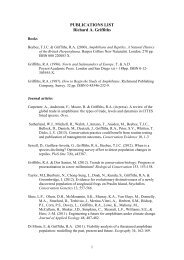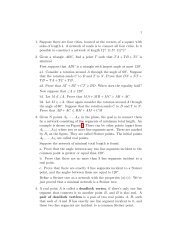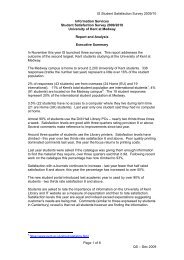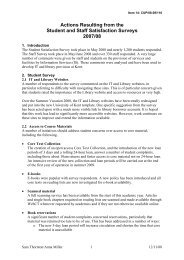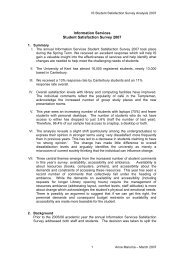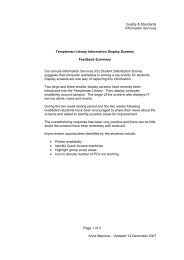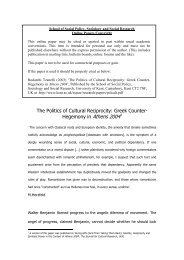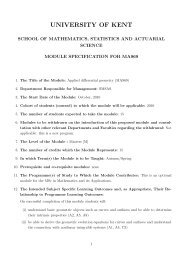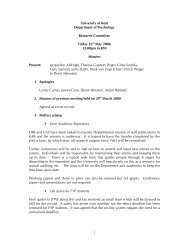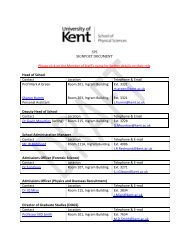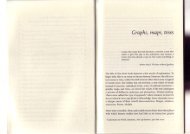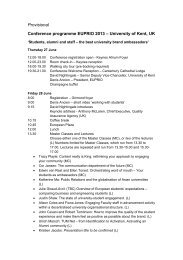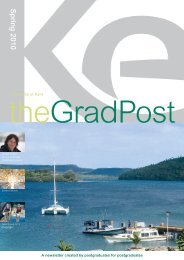Download - University of Kent
Download - University of Kent
Download - University of Kent
Create successful ePaper yourself
Turn your PDF publications into a flip-book with our unique Google optimized e-Paper software.
<strong>University</strong> <strong>of</strong> <strong>Kent</strong> / ARTS STUDIO<br />
DISCOVER YOUR<br />
PLACE IN ART<br />
HISTORY<br />
If you think an art history degree means<br />
three years with your nose in a book and<br />
the odd gallery visit, read on. <strong>Kent</strong>’s History<br />
& Philosophy <strong>of</strong> Art team <strong>of</strong>fers better ways<br />
to teach this subject.<br />
The <strong>Kent</strong> History & Philosophy <strong>of</strong> Art BA (Hons) programme includes<br />
buying works <strong>of</strong> art, writing arts’ reviews, overseas study trips and handson<br />
work experience. Among other careers, graduates go on to be<br />
journalists, auctioneers, teachers, curators and PR agents. This is one <strong>of</strong><br />
the reasons we are ranked second in the UK for art and design graduating<br />
students' employment prospects in The Guardian <strong>University</strong> Guide 2011.<br />
It also makes our degrees more interesting, <strong>of</strong> course. Here are some<br />
<strong>of</strong> the things that <strong>Kent</strong>’s art history students typically get involved with as<br />
part <strong>of</strong> their degree programme.<br />
SHOP<br />
We give second and third-year students a budget and a mission – to go<br />
out and buy works for the School <strong>of</strong> Arts’ world-class print collection. They<br />
can ask for advice but they are also free to make mistakes and everyone<br />
gets marked on how well they do.<br />
The prints they buy form the basis for an annual exhibition. We then<br />
add all the student purchases to our collection <strong>of</strong> several hundred works<br />
back in Canterbury. This includes prints by leading artists and printmakers<br />
including Sir Peter Blake, Tracey Emin, Jake and Dinos Chapman and Ana<br />
Maria Pacheco.<br />
MAKE<br />
The best way to learn about Old Master drawing and painting techniques<br />
is by having a go yourself. If you try drawing like Rembrandt, you get firsthand<br />
experience <strong>of</strong> his materials and processes.<br />
We don’t assess students on the quality <strong>of</strong> their drawings. However,<br />
we do expect them to use their practical experience as the basis <strong>of</strong> formal<br />
written assessments on topics such as the role <strong>of</strong> drawing in the theory<br />
<strong>of</strong> ‘disegno’. And, if you know how hard it is to make marks with chalk<br />
on paper in the style <strong>of</strong> Michelangelo, you will get a deeper appreciation<br />
<strong>of</strong> the original works. You may also find it easier to spot a fake.<br />
The same goes for photography. If you develop your own work in a<br />
darkroom using traditional techniques you will get a better understanding<br />
<strong>of</strong> the form.<br />
WRITE<br />
On our Visual Arts Writing module, students are introduced to the basics<br />
<strong>of</strong> writing for publication by those who have done it – rather than by those<br />
who just talk about it.<br />
All students write essays but we teach our students how to write<br />
pr<strong>of</strong>essionally and how to adapt to different ‘house styles’. So many jobs<br />
in the art world (think <strong>of</strong> critics, curators, dealers and publicists) rely on<br />
strong writing skills. As a result, no one in the business can afford to<br />
divorce style from content.<br />
Our students write pieces for newspapers, magazines, catalogues<br />
and publicity material. Their brief is to produce readable, engaging copy<br />
on contemporary art world issues and some <strong>of</strong> this work has even been<br />
accessioned to the British Library.<br />
MANAGE<br />
The School <strong>of</strong> Arts’ Studio 3 Gallery hosts exhibitions <strong>of</strong> work by<br />
renowned artists throughout the year. (To find out more, see our blog at<br />
http://blogs.kent.ac.uk/studio3gallery) Each summer, our second and thirdyear<br />
students put on an exhibition in the Studio 3 Gallery. We expect them<br />
to reach pr<strong>of</strong>essional standards. Using the works they bought, they<br />
catalogue, curate and publicise their additions to the <strong>Kent</strong> print collection.<br />
This event is now a fixture on the local art scene and gets great reviews.<br />
International journal, Print Quarterly (XXVII, 2010, 4), described Krikey!<br />
<strong>Kent</strong>emporary Prints as ‘refreshing and optimistic...an example <strong>of</strong> how<br />
ingenuity and enthusiasm can overcome lack <strong>of</strong> financial resources’. The<br />
review went on to commend the ‘liveliness <strong>of</strong> the writing’ and ‘impressive<br />
list’ <strong>of</strong> featured artists.<br />
Our teaching methods mean that students leave our course with<br />
tremendous confidence and practical skills as well as a thorough<br />
grounding in the subject. If you can project manage an exhibition, spend<br />
a budget wisely, write a press release and challenge the authenticity <strong>of</strong> an<br />
Old Master drawing, you will also have a head start in any chosen career.<br />
12



